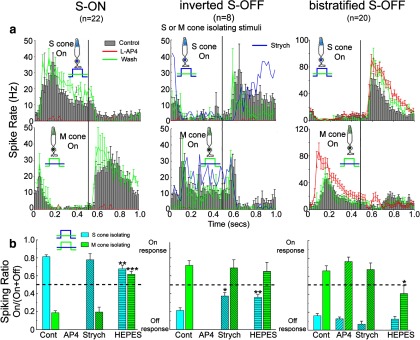Figure 2.

The three types of S/M opponent ganglion cells have different response properties when cone-isolating stimuli were used to stimulate S-cones or M-cones in isolation. The diagrams of cone-isolating stimuli represent relative cone capture for the S-cones and M-cones, where there is high contrast for one cone type and low contrast for the other type. Vertical lines separate responses to the onset phase of each isolating stimulus from the responses to the offset phase. a, Poststimulus time histograms for control and red (L-AP4) and green (washout of L-AP4) traces represent the mean spike rate ± 1 SE (where shown) for all cells tested for the cell type and drug condition portrayed. Strychnine data (blue lines) is shown for only the inverted S-OFF ganglion cell. The S-ON ganglion cell (left) spikes at the onset of S-cone stimulation (top) or the offset of M-cone stimulation (bottom). The two S-OFF ganglion cells (center, right) had the opposite polarity. L-AP4 (red traces) reversibly abolished spiking in the S-ON and inverted S-OFF cells, but not the bistratified S-OFF cell. b, ON or OFF polarity was quantified for S- or M-cone-isolating stimuli by dividing spiking in the onset phase by total spiking. Antagonistic polarities were seen for all three cell types. L-AP4 did not alter opponency in the bistratified S-OFF type. Strychnine (Strych) did not significantly alter opponency except in the inverted S-OFF type, where the S-cone offset response was blocked. HEPES buffer reduced horizontal cell-mediated antagonism from M-cones in both the S-ON (t(34) = 11.45, p < 0.001) and bistratified S-OFF ganglion cells (t(35) = 3.465, p < 0.05) and reduced the selectivity for OFF stimuli in the inverted S-OFF ganglion cell (t(9) = 2.66, p < 0.05). It also reduced the ON polarity of the S-cone-isolated response for S-ON ganglion cells (t(33) = 3.413, p < 0.01). All comparisons are between controls (Cont) and drug treatments.
